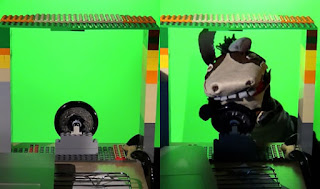Introduction
The idea was to do a very short (perhaps as little as one minute long) animation on the nativity story for Christmas, with an offbeat theme. I liked the idea of giving donkeys some agency, so Mary's old donkey retires and presumably arranges for a replacement, a time-travelling taxi-driving donkey (from a future Donkey Civilization? who knows). Anyway, after some development of the story, I captured the gist in a mini storyboard.

Process
I wanted to use felt shapes originally, but in the timescale I decided to use felt and other textures photographed and imported into Adobe Flash CS5. This is perhaps the last hurrah for my Creative Suite 5, since it will no longer work with the next version of MacOS. However, as the story was to be driven by the narration of the donkey-taxi-driver, I thought this character might be easier to animate as a sock-puppet, especially as it would be sitting behind the steering wheel all the time.

I thought about a uniform or cap for the donkey, but that seemed too fiddly and unnecessary, so I looked for more naturalistic style.

I used an old sports sock, cutting two holes for little finger and thumb (for donkey's forelegs to operate steering wheel) and a large gap for the mouth. I covered the sock with felt and sponge padding (cut from an old seat filling), only receiving a few mild burns from my hot glue gun. Note to self: upgrade health and safety. The donkey's ears were wire loops at each end of a wire bent to include a neck support, covered in moulded wire mesh, masking tape and a top layer of felt. The idea was that the ears would be bent as if by the roof of the taxi cab. The forelegs were made as separate digit-mittens, with moulded black plasticine hooves with neodymium magnets embedded to (hopefully) contact with the metal steering wheel, made from a jar lid. The donkey's mouthparts had space at top for middle finger and below for the other two fingers so I could animate the mouth for rough lip-synching.
The steering wheel was stuck inside a frame built of LEGO®, clamped to sturdy laptop desk, placed in front of green card, and lit by three LED lights. The video camera was placed on a tripod and zoomed in to accommodate the frame. Then the donkey sock puppet was positioned with its hooves holding the wheel, and videoed lip-synching with the pre-recorded (in Apple GarageBand) narration.

The video was then taken in segments into Apple iMovie, synchronised manually to the audio output in segments from Garageband, and edited to length. Each video segment (still rotated 90° from upright) was then exported as QuickTime movies. To crop, rotate and remove the green backgrounds, the videos were then imported into Apple Motion. After cropping, rotating and resizing (to about 540 pixels square) the keyer filter was applied, which automatically detected the green colour, and then the right slider in the spill contrast had to be slid all the way to the left to fully remove the background. The video was then exported with the alpha (transparency) channel.
To get the video into Adobe Flash, it was first converted into FLV (Flash video format) by Adobe Media Encoder. Once in Flash, it was placed like any imported video without using a surround. The audio was retained in the imported video through these operations.
The rest of the work in Flash was relatively straightforward. Some simple effects were used, and mostly very simple shapes with imported textures as bitmap fills with minimal animation were created.
I wanted to finish up back at the start (Mary and Joseph's Carpentry in Nazareth) to illustrate that the original donkey had retired, not "retired", as might have been implied by the narrator, and indeed had been joined by her replacement. This is where a photograph of the puppet was broken up into slightly simplified Flash shapes, and a slightly smaller mirror copy was elderified into an old white donkey. This hopefully help tie up the different visual styles and produce an adequate ending to animation already about 2 minutes long.

Result
Reflecting back, a major theme was time, probably not surprising considering how time-consuming animation can be, and in this case a looming deadline of Christmas Eve, which I met before tea-time when I uploaded the video and English captions. There were some weak gags and observations, and Mary was not simply a passenger either. While this project was essentially another animation test (and my first green-screen foray, thanks to a useful tip from the Internet), it also met my original concept and was completed on time (even if I had to buy Apple Motion, it was worth it).
No comments:
Post a Comment